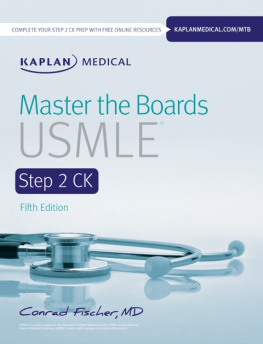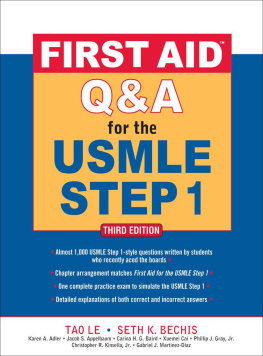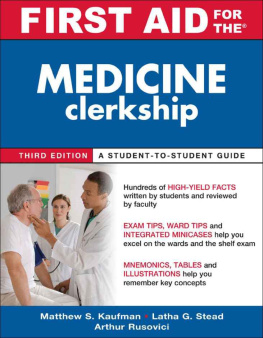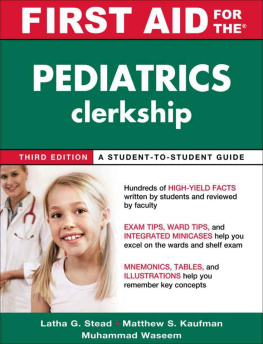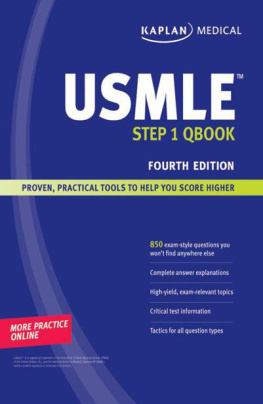Notice
Medicine is an ever-changing science. As new research and clinical experience broaden our knowledge, changes in treatment and drug therapy are required. The authors and the publisher of this work have checked with sources believed to be reliable in their efforts to provide information that is complete and generally in accord with the standards accepted at the time of publication. However, in view of the possibility of human error or changes in medical sciences, neither the authors nor the publisher nor any other party who has been involved in the preparation or publication of this work warrants that the information contained herein is in every respect accurate or complete, and they disclaim all responsibility for any errors or omissions or for the results obtained from use of the information contained in this work. Readers are encouraged to confirm the information contained herein with other sources. For example and in particular, readers are advised to check the product information sheet included in the package of each drug they plan to administer to be certain that the information contained in this work is accurate and that changes have not been made in the recommended dose or in the contraindications for administration. This recommendation is of particular importance in connection with new or infrequently used drugs.
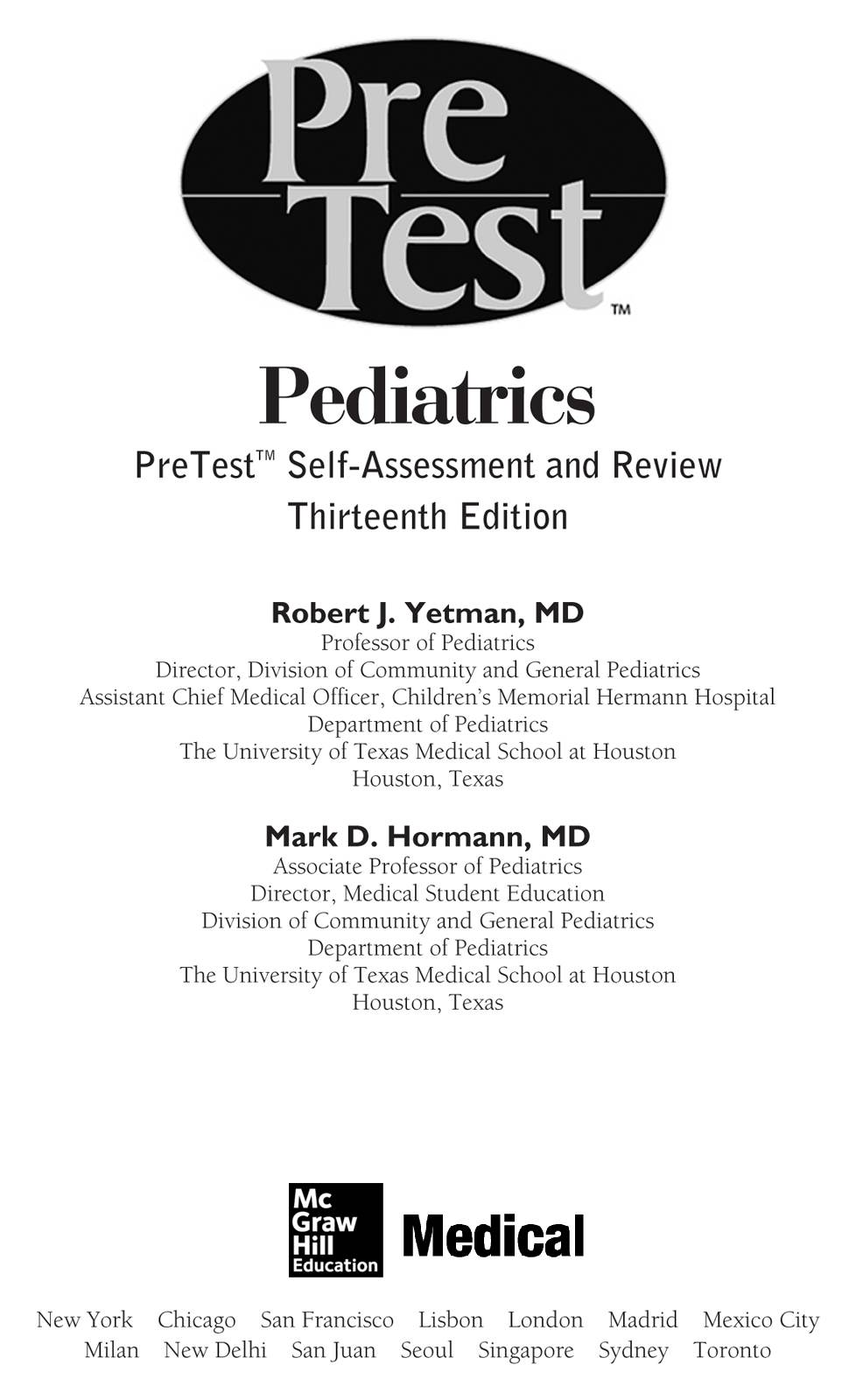
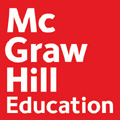
Copyright 2013, 2009, 2006, 2003, 2001, 1998, 1995, 1992, 1989, 1987, 1985, 1982, 1978 by The McGraw-Hill Education. All rights reserved. Printed in China. Except as permitted under the United States Copyright Act of 1976, no part of this publication may be reproduced or distributed in any form or by any means, or stored in a database or retrieval system, without the prior written permission of the publisher.
ISBN: 978-0-07-176122-2
MHID: 0-07-176122-5
The material in this eBook also appears in the print version of this title: ISBN: 978-0-07-176123-9, MHID: 0-07-176123-3.
All trademarks are trademarks of their respective owners. Rather than put a trademark symbol after every occurrence of a trademarked name, we use names in an editorial fashion only, and to the benefit of the trademark owner, with no intention of infringement of the trademark. Where such designations appear in this book, they have been printed with initial caps.
McGraw-Hill eBooks are available at special quantity discounts to use as premiums and sales promotions, or for use in corporate training programs. To contact a representative please e-mail us at bulksales@mcgraw-hill.com.
TERMS OF USE
This is a copyrighted work and The McGraw-Hill Education. (McGraw-Hill Education) and its licensors reserve all rights in and to the work. Use of this work is subject to these terms. Except as permitted under the Copyright Act of 1976 and the right to store and retrieve one copy of the work, you may not decompile, disassemble, reverse engineer, reproduce, modify, create derivative works based upon, transmit, distribute, disseminate, sell, publish or sublicense the work or any part of it without McGraw-Hills prior consent. You may use the work for your own noncommercial and personal use; any other use of the work is strictly prohibited. Your right to use the work may be terminated if you fail to comply with these terms.
THE WORK IS PROVIDED AS IS. McGRAW-HILL AND ITS LICENSORS MAKE NO GUARANTEES OR WARRANTIES AS TO THE ACCURACY, ADEQUACY OR COMPLETENESS OF OR RESULTS TO BE OBTAINED FROM USING THE WORK, INCLUDING ANY INFORMATION THAT CAN BE ACCESSED THROUGH THE WORK VIA HYPERLINK OR OTHERWISE, AND EXPRESSLY DISCLAIM ANY WARRANTY, EXPRESS OR IMPLIED, INCLUDING BUT NOT LIMITED TO IMPLIED WARRANTIES OF MERCHANTABILITY OR FITNESS FOR A PARTICULAR PURPOSE. McGraw-Hill and its licensors do not warrant or guarantee that the functions contained in the work will meet your requirements or that its operation will be uninterrupted or error free. Neither McGraw-Hill nor its licensors shall be liable to you or anyone else for any inaccuracy, error or omission, regardless of cause, in the work or for any damages resulting there from. McGraw-Hill has no responsibility for the content of any information accessed through the work. Under no circumstances shall McGraw-Hill and/or its licensors be liable for any indirect, incidental, special, punitive, consequential or similar damages that result from the use of or inability to use the work, even if any of them has been advised of the possibility of such damages. This limitation of liability shall apply to any claim or cause whatsoever whether such claim or cause arises in contract, tort or otherwise.
Student Reviewers
David Lee
Third Year Medical Student
SUNY Downstate Medical Center
Class of 2011
LaToya Roberts
Third Year Medical Student
UMDNJ-SOM
Class of 2011
Rory Snepar
Third Year Medical Student
UMDNJ-SOM
Class of 2011
Contents
Introduction
Pediatrics: PreTest Self-Assessment and Review, Thirteenth Edition, provides comprehensive self-assessment and review within the field of pediatrics.
The 500 questions in the book have been designed to be similar in format and degree of difficulty to the questions in Step 2 of the United States Medical Licensing Examination (USMLE). They may also be a useful study tool for Step 3 or clerkship examinations.
For multiple-choice questions, the one best response to each question should be selected. For matching sets, a group of questions will be preceded by a list of lettered options. For each question in the matching set, select one lettered option that is most closely associated with the question.
Each question in this book has a corresponding answer, a reference to a text that provides background to the answer, and a short discussion of various issues raised by the question and its answer.
To simulate the time constraints imposed by the qualifying examinations for which this book is intended as a practice guide, the student or physician should allot about one minute for each question. After answering all questions in a chapter, as much time as necessary should be spent in reviewing the explanations for each question at the end of the chapter. Attention should be given to all explanations, even if the examinee answered the question correctly. Those seeking more information on a subject should refer to the reference materials listed in the bibliography or to other standard texts in medicine.
General Pediatrics
Two weeks after a viral illness, a 9-year-old boy presents to your clinic with a complaint of several days of weakness of his mouth. In addition to the drooping of the left side of his mouth, you note that he is unable to completely shut his left eye. His smile is asymmetric, but his examination is otherwise normal. His photograph is shown. Which of the following is the most likely diagnosis?

(Reproduced with permission from Knoop KJ, Stack LB, Storrow AB. Atlas of Emergency Medicine. 2nd ed. New York, NY: McGraw-Hill; 2002.)
a. Guillain-Barr syndrome
b. Botulism
c. Cerebral vascular accident
d. Brainstem tumor
Next page

